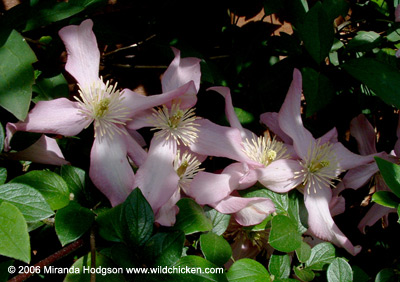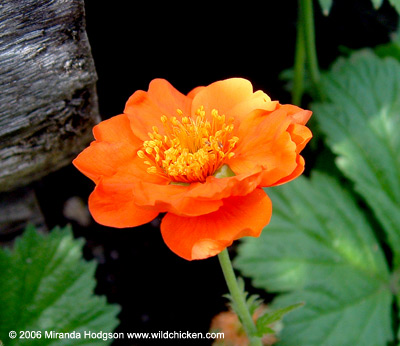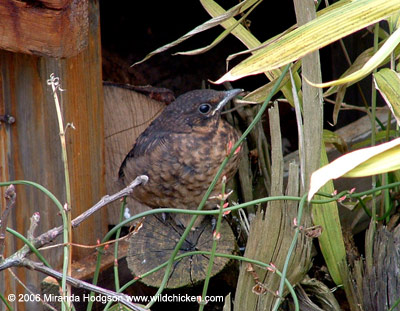26th May 2006 - In praise of our lawn
The weather at the moment reminds me of a line from an Australian film, Bliss (taken from the novel of the same name, by Peter Carey). The main character, Harry Joy, is known for mesmerising listeners with the wonderful stories he tells and, in one, he relates the tale of how his parents met, when they were both involved in rescuing church valuables from some flooding. He goes, ‘It rained and it rained, and nobody thought it would ever stop’.
‘It rained and it rained, and nobody thought it would ever stop’
Well, it’s been a bit like that here. During the last week of April, we sorted out what we call ‘the sitting place’, placing the wooden table and chairs, giving them a good brushing and putting a few potted plants on the ancient wooden work bench next to them. We were anticipating the first barbecue of the year, discussing the merits of various marinades, looking forward to a meal outside. Almost as soon as we finished, the rain started and it’s hardly stopped since. The pond is brimming, the water butts are full to the top and I haven’t needed to water anything for about three weeks.
Encouraged by all this moisture, and the increasing warmth, the garden has suddenly exploded with growth. Delightful as it is to see the beds filling out with form and colour, the lawn has been growing at the same rate. All I was able to do for nigh on three weeks was to simply watch as it grew longer by the day. Now I’m not one for a perfect, weed free lawn - I’ll allow the daisies and clover some space – but I do like to see it neatly cut and edged. The beds can be as wild as you like, but if they enclose a sharply edged lawn, all of one length, then somehow everything holds together so much better. The lawn is curved to flow round one side of the house, ending at the big old apple tree, and the sharpness of the edge emphasises the green river effect. If it gets overgrown it reduces the illusion of space and smoothness that this curved stretch gives.
The length must be no less than 3cm, mind you, I don’t like to see lawns so short that they turn wan and pale. In the summer the cut will be 4-4.5cm as it always stays green. Doing it this way means that the lawn has never been watered, except by the rain, but it has never yet turned yellow in summer. I know that green lawns are forecast to be become a thing of the past, and that wanting one will become un-trendy, but I like ours and think it makes a big difference. I try to imagine the garden without it and can’t. If the day should come when lawns are no longer practical then I’ll adjust but, right now, I love it.
Anyway, the rain stopped for long enough for the lawn to be cut and now it looks about a thousand times better; the effect is very like that of a freshly vacuumed carpet, all smooth and clean. I must have looked at five weather sites, trying to gauge if it was worth me scheduling the time to get it done and, after fretting over it, I reckoned there could be a rain free window of four to five hours during the middle of the day. I started by giving it a light brushing over, to knock off the water droplets, then did some other jobs for an hour or so while it dried out a bit more. My usual method of combined edging and weeding completed, it was ready to cut. I don’t enjoy lawn mowing as much as planting and general pottering, but what a pleasure, what a relief, to see the job done.
So, what is this lawn setting off just now? Well, there’s Spiraea japonica 'Goldflame', with its glorious fiery colours, which sits in front of a Ceanothus. It’s unfortunate that this blaze will soon be joined by fluffy ice-cream pink flowers, but let’s try not to think about that just now, shall we? Then there are the dark-leaved Heucheras I’ve been dividing, which seem to settling in well. The richness of the glossy purple leaves goes perfectly with the green of the lawn. Clematis ‘Warwickshire Rose’, now four years old, is beautiful this year, growing along the fence and making its way over the shed.

Clematis 'Warwickshire Rose'
Nearby, there are the vivid orange flowers of Geum 'Borisii' and some late flowering bluebells. I bought the Geum ‘Borisii’ during a lapse in concentration; they were meant to be Geum rivale and the intensity of the flower colour was quite startling at first, but I like them now. They’re very like Geum ‘Princess Juliana’, mentioned from the Chelsea Flower Show.

Geum 'Borisii'
Against the south facing wall the Sicilian chamomile, Anthemis punctata subsp. cupaniana, is in full bloom, its yellow and white daisy flowers spreading through a small stand of Libertia peregrinans on one side and a flowering Euphorbia Redwing on the other. A Cerinthe major 'Purpurascens' at the front of the south facing bed is also in full flower, its tubular pink-purple flowers looking gorgeous, the leaves almost metallic in the sunlight.
In amongst all this fecundity are the young birds who are brought to the garden every year at this time. Two of the three young blackbirds born last month are still in the garden (one, unfortunately, died after it was hit by a car). They can fly now, but haven’t moved on yet. Along with them, scuttling, rustling, tweetling and squawking under the shrubs are young sparrows, dunnocks, doves and starlings. I wonder if they think that it’s their garden?

Young blackbird, fledged three days
They certainly make good use of it when we’re indoors - sitting on our chairs, going in and out of the greenhouse through the gap under the door, stretching out on the compost of sheltered pots when there’s a bit of sunshine. I watch them while I’m washing up and enjoy the spectacle so much that we’ve had to buy a metal cafetierre (CRACK! ‘Blast, there goes another one…’ you get the idea).
© Copyright Miranda Hodgson 2006